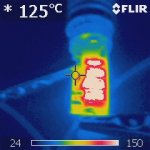- Joined
- Feb 5, 2008
- Messages
- 6,252
- Points
- 83
Well said, dude!It's still a hobby for me too, I enjoy designing and making these performance drivers so that all kinds of tiny builds are possible for all forum members. Every time it's like a new puzzle that needs to be solved as to how much can be crammed into such a small space, and maintain as much flexibility as possible. In the past I've gone the route of hand assembling drivers whenever someone needed one, and after a few months it's just not maintainable. But when you have the ability as you do, making them for yourself and a couple (not wearing yourself out) for others is great.
I can sure hand solder a sh't load of drivers, given the etched PCBs are already done.
Oh and I'm purchasing a new soldering station next week... somebody stop me!
Puzzle to solve, sure is, when a driver like Flex has so many components.
But you can easilyfabricate double sided PCBs.
I have to do with single sided, and routing the traces is not easy. Well, for first few times, later you can already do it without having the IC handy , to use it while drawing on PCB - you just kind of learn the spacings and dimensions by heart.
But your drivers are unsurpassed. What is the efficiency of a flex drive when powering GGW (200mA) from one lithium ion (full charge but given the voltage drop down to 4V when powered)?
I calculated mine to be around 67.8% since it's drawing 350 mA.
Thatot exactly ideal, but it's better than cramming 2x CR123 and DDL driver into the thing.
If you are going to insult my nickname, at least do it with style.hey Happy man (heheheh) remember how you helped me with that blu ray driver???
i salvages through probably 11 old things and got the parts for yourdriver!!!!! i made one (geez there hard to solder SMD. lol but i hooked it up to 6V and a test load and the voltage reg like craked in half :crackup::crackup: maybe i should ask help before doin it next time i failed misserably
You got it wrong.
Discussed via Skype, wrong IC used. Better luck next time.





